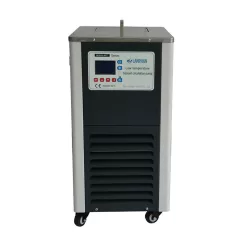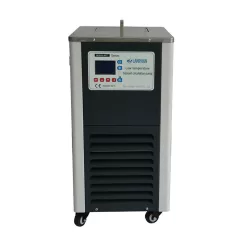[ux_image id=”24675″ height=”59%” lightbox=”true” caption=”true” image_hover=”fade-in” image_hover_alt=”zoom”]
[gap]
As a cooling system, a chiller can cool materials down by removing heat from a liquid via a vapor-compression or absorption refrigeration cycle. The liquid gets circulated through a heat exchanger to cool equipment. In a chiller system, there is always a liquid working as a refrigerant going through the heat exchanger in order to transfer the heat energy. When the heat gets absorbed by the liquid, materials get chilled.
What Types of Chillers are There?
There are two main categories of chillers, which are vapor absorption chillers and vapor compression chillers. The former utilizes heat to move the refrigerant around the system, while the latter uses an electrically driven mechanical compressor to force a refrigerant around the system.
The most commonly used chillers are vapor compression ones, which can be further categorized into air chillers and water chillers. They have the similar components, which are the evaporator, the compressor, the condenser and the expansion valve. What’s more, they also have the similar mechanics. The refrigerant is moved by the compressor around the interior of the chiller to go through the condenser, the expansion valve, the evaporator, and back to the compressor.
What is the Difference Between Air-Cooled Chiller and Water-Cooled Chiller?
- Different source of heat exchange. As their name suggests, the water-cooled chiller takes water as the source of heat exchange, which is equipped with a special cooling tower. But the air-cooled chiller takes gas as the source of heat exchange, which is equipped with a special fan.
- Different working manners. A water-cooled chiller uses the cooling tower and water pump to extract hot water for heat dissipation, allowing the cooling process to circulate. But the working principle of an air-cooled chiller varies from that of a water-cooled chiller. The air-cooled one mainly uses the fan for heat dissipation.
- Different installations and using methods. A water-cooled chiller only can be used when its external is equipped with the water tower and pool, while an air-cooled chiller is movable requiring no water tower and pool.
- Different water requirement and installation area. For a water-cooled chiller, it requires less water and small installation area. It is easy and cheap to maintain a water-cooled chiller. But an air-cooled chiller needs more water and larger installation area. It is quite expensive to maintain an air-cooled chiller.
How does a Chiller Work?
As there are various kinds of chillers, they have the same working principle. A chiller system is about transferring and taking in the heating energy. Hence, the transformation of heating energy is the basic working principle of a chiller system. In the working process of a chiller system, the heating energy get transferred from a kind of material or any other thing to a middle solvent or substance. In the process of transferring heating energy, the pointed materials’ heating energy get absorbed and turned into a cold situation, which is the destination of a chiller system.
Which Type of Chiller is Best?
It is generally recognized that water-cooled chillers are better than air-cooled chillers, which are mainly shown in the following aspects.
Firstly, the water-cooled chillers are more high efficient than air-cooled chillers.
Secondly, the water-cooled chillers are applicable for small-scale cooling as well as commercial-scale cooling.
Last but not least, the water-cooled chillers are much quieter during the operation compared to air-cooled chillers.
What are Chiller Components?
A complete chiller is basically composed of the following components: a condenser, a compressor, an evaporator, an expansion valve, a power unit, water box and a control unit.
The condenser can remove heat from the refrigerant, including air and water cooled condensers.
The compressor is the most important component in a chiller system, which can ensure the movement of the refrigerant throughout the system.
The evaporator can collect heat from the structure and send it to the cooling tower.
The expansion valve can expand the refrigerant to increase its volume, thus allowing the refrigerant to absorb heat in the evaporator.
The power unit controls the electricity supply to the chiller.
The water box usually directs the flow and separates the entrance from the exit.
The control unit can observe and manage the performance of a chiller.
All in all, the above components all play an important role in a good operation of a chiller.
What are the Different Types of Refrigeration Compressors?
Compressors can be divided into rotary compressors, axial compressors, jet compressors and screw compressors and other types, of which the most widely used is reciprocating (piston) compressors according to the structure of multiple compressors.
[title text=”reLATED pRODUCTS” tag_name=”h2″ color=”rgba(32, 163, 219, 0.81)”]
[title text=”Related Posts” tag_name=”h2″ color=”rgba(32, 163, 219, 0.81)”]
https://www.rotovap.cn/chiller/6716.html
https://www.rotovap.cn/chiller/6656.html
https://www.rotovap.cn/chiller/6408.html



